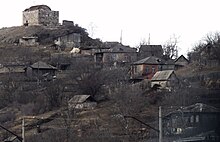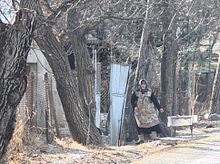CIVICS/Field Trip to Javakheti, 2012-03








The field trip is part of the research activities of Socio-economic Tools for Integrated Conservation Planning in the Multi-Ethnic South Caucasus taking place in March 2012.
March 15, 2012 (Trip from Tbilisi to Akhaltsikhe)
[edit | edit source]We left Tbilisi in northern direction following the Kura River (Georgian: Mtkvari) upstream (Road 1 and E60) at about 9:00 hrs. At the northern edge of the Tbilisi Valley, the river and the main road takes a few turns west and northwards again passing the old capital of Mtskheta. The river cuts through the ridge to the north of Tbilisi Valley, and road and river turn west again. The valley lowland is about six km wide. To the right of the motorway, there is a refugee camp for ethic Georgians stemming from nearby South Ossetia (see image). The motorway continues in west-north-westerly direction at the southern edge of the valley that widens to the north in form of a triangle with the capital of South Ossetia, Tskhinvali, at its tip at the southern shore of the Greater Caucasus. For a short distance, the border of South Ossetia directly borders the motorway.
The motorway passes Gori to the north. Right after the city, a new bridge for the motorway is being built that will soon connect to an already existing new tunnel. A short time later, the motorway gives way to a road; we turned south into the mountains, towards Borjomi. Hay was being sold at the roadside; as winter fodder is a scarce resource, this was a common sight. In Khashuir, the Road 1 branches to the north away from the Kura while Road 8 continues west-southwestwards along the river. In Khviskheki, the road enters from the plain into the mountains.
In Borjomi is the center of the forested Borjomi-Kharagauli National Park area, and a famous spa. Slowly meandering up along the Kura River in the Borjomi_Gorge, road finally exists the mountains where the Kura valley slowly widens. All the way, we were accompanied by an electrified railroad. A few kilometers later, we passed the site where UNDEP, GEF and ELKANA sponsor an "Experimental-Demonstration Base" in the village of Tsini.
Soon, the road and the railroad arrive at Akhaltsikhe, the capital of the Samtskhe-Javakheti Region (Gerogian: Mkhare). We stayed in a Hotel just ouside town on the northern banks of the river where we arrived at about 13:30 hrs.
What else did we do that day?
- I think we had a first meeting at lunch time with Maia and the gentleman from the local farmers union. What was his name? (Tamasi?)
March 16, 2012: Akhaltsikhe
[edit | edit source]- Tsini demonstration plot and project operated by ELKANA and supported by UNED and the GEF (details on "forgotten" grains conserved there)
- modern dairy operation (no business in winter becasue of low fodder availability) not far away
- local government
- Maia's extension practice room at Akhaltsikhe University
- visit to TV station with interviews
March 17, 2012 (trip to Akhalkalaki)
[edit | edit source]In Akhaltsikhe, the Kura River coming from the south, and the Potskhovistskali River coming from the west meet. We took the road (Road 11, E691) along the Kura River as it leads deeped into Javakheti, closer to area of Alkhalkalaki and Nimotsminda - i.e. closer to the Javakheti National Park. The largest village enroute is Aspindza. The confluence of the smaller Paravani River and the Kura River occurs about 20 km before reaching Alkhalkalaki. The confluence is overlooked by the quite well preserved ruins of Khertvisi fortress. The road to Alkhalkalaki follows the Paravani River to the east while the Kura turns westwards to the Kars Highlands of Turkey.
Arriving in Akhalkalaki, we first had a meeting with the major of the district (name?). The major was of Aremenian descent; all official signs were bi-lingual. In town, also the resent past with heavy presence of the Russian military is still visible with many commercial signs still in kyrillic. The meeting at the town hall was jointed by the local WWF representative. WWF has an office in Akhalkalaki where local planning for Javakheti National Park takes place. After the date with the major, we had lunch with the WWF respresentative. NExtr, we went to his office (supported by KfW), where he introduced us to some of the current NP planning issues.
The group split. With Gizo and Susanna, Jan went to the office of the Public Defender of Goeorgia to discuss ethnic minority issues as well as the perception of public participation options with respect to national park planning.
- The second party went to Nimotsminda. Who was met there?
Finally, we visited a dairy plant. E.g. butter and sweets were produced here, partly for export.
The same day, we followed the same route back to Akhalhalaki.
In the evening, we had a celebration in honors of Mr. Gizo's 60th birthday in the hotel.
March 18, 2012 (trip to Akhalkalaki)
[edit | edit source]Way back to Tblisi.
